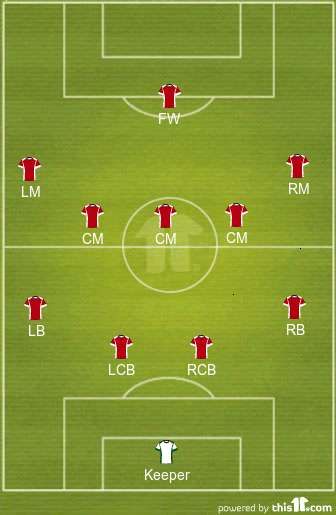
Football tactical systems explained: 4-5-1
Ever find yourself fascinated by how teams battling it out in the lower end of the table consistently manage to punch above their weights in the Premier League?
Look no further than the 4-5-1 formation.
This system emphasises on a heavily packed midfield to cut off passing lanes to the opposition attacking players; thus it can be seen frequently implemented by teams marred in a relegation battle come the business end of the season, due to the defensive solidity it offers. Sam Allardyce, in particular, used it to great effect to stave off relegation for his Sunderland side that have become infamous for regularly pulling off ‘great escapes’.
Tony Pulis often still sets his teams out to this system, with Solomon Rondon at West Brom currently taking up the role of lone central striker; and his record speaks for itself; Pulis has never been relegated from the Premier League.
Also Read: Tactical systems explained: 4-3-3
It is also regularly used by managers to avoid defeat in difficult away games in knockout competitions.
But it is often looked down upon as a system that enforces a so-called ‘negative football’; what it provides in defensive stability and tempo management, it sacrifices in attacking threat. The 2 wide midfielders in the system are often deployed as ‘defensive wingers’ to help cover full-backs against opposition forwards.
A popular variation of this system is the 4-1-4-1, which is usually employed by teams at the deeper end of games to defend leads. It has gained popularity over the years due to the 3 in central midfield providing a great deal of tactical flexibility.
Strengths:
To put it simply, a team deploying the 4-5-1 will be seeing quite a bit of the ball. They’ll be dominating the game possession wise, due to the large number of bodies packed into the midfield; the lone striker sometimes will drop deeper to collect the ball, meaning it variates to a 4-6-0, making it incredibly difficult to penetrate the lines.
Also Read: Football tactical systems explained: 3-5-2
The system also allows for attacking flexibility. The 2 wide midfielders, who occupy the ‘defensive winger’ role while the team is defending, can quickly push higher up the pitch to change the formation to a crude resemblance of the 4-3-3. This allows the team to adjust their play proactively to a situation, without the manager having to make knee-jerk substitutions.
In the 2011-12 season, Alex McLeish used it to great effect at Aston Villa. He had the right personnel to grind out the results that were required for Villa to stay up in the league. By deploying Stiliyan Petrov as the deepest lying midfielder, he ensured that the base of midfield was well covered, with Petrov registering the highest number of interceptions in the league before being unfortunately stricken by illness.
Weaknesses:
Given the focus on controlling midfield, the striker may be isolated up-front for long portions of the game. Usually given instructions to stay back in midfield to win back possession and fight for second balls, the midfielders are less likely to burst forward to support the strikers. As a result, the system would not do very well in chasing a game. Managers often shuffle it up to a more attacking 4-3-3 or a 4-2-3-1 should the team concede the first goal.
Another disadvantage would be the added difficulty in launching a counter attack while playing in this system. It’s not by any means impossible, but it places heavy emphasis on the striker to reliably hold up play so that the midfielders can join in on the attack and influence passing sequences. This delay gives the opposition defenders the time to recover and reclaim their positions, usually nullifying any threat in the process.
Also Read: Tactical systems explained: 4-4-2
The strikers and wide midfielders are also under constant pressure in this system. The midfielders have to relentlessly work up and down the flanks and are also expected to make countless runs forward to support the attack, but are rarely rewarded for doing so. The striker, on the other hand, is responsible for initiating defensive pressure on the opposition and funneling them into wider areas. Because chances are so few and far between, the onus would be on him to be clinical and finish the few that do come his way.
Conclusion:
It is quite easy to brand the 4-5-1 as a counterattacking, ‘safe’ formation. Many believe it to be a negative brand of football. However, with its ability to transition between the 4-3-3 or the 4-5-1 during attacking and defensive phases of the game respectively, it offers a semblance of tactical flexibility to the manager.
The 4-5-1 is an excellent formation of choice for teams at the lower end of the table, fighting it out for survival. It provides a stable platform to build a team and achieve consistent results.
However, for a team looking to consistently score goals and blow away opponents, it simply does not offer enough, in terms of attacking credibility or fluidity.


